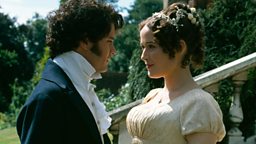A step-by-step guide to dating – Georgian style
On a very special Valentine’s Day episode of You’re Dead To Me, host Greg Jenner is joined by historian Dr Sally Holloway and comedian Cariad Lloyd to discuss the rules and rituals of courtship in Georgian Britain.
Read on for some top tips on finding and wooing your very own Mr Darcy or Miss Bennet…
Step 1: Identify a potential love interest
We might imagine that in the 18th and early-19th centuries, people only married for status, money, or to produce heirs. But the ideology of romantic love was important in this period, and it was hoped that love would exist before marriage. So, should you find yourself back in Georgian England, make sure to find someone – perhaps at a fair, a ball, or the theatre – who you actually fancy! The importance of love didn’t mean that money and social class were totally irrelevant though. As Matthew Boulton wrote at the time: ‘Don’t marry for money, but marry where money is.’

Step 2: Make sure your family and friends approve
A couple’s social network was instrumental in any proper courtship. Families and friends would subtly cajole their loved ones into finding and courting the right partner: helping to find appropriate suitors, vetting potential love interests, and overseeing the courtship. Their approval was also necessary for the eventual marriage. The process of finding a spouse in this period has been described by historian Joan Perkin as a “willing drift into a suitable alliance”. Who said romance is dead?!
Step 3: It’s time to hit the shops
Gift-giving was an essential component of Georgian courtships. In the early days of a flirtation, men might even send gifts to multiple women to see who responded best (the 18th-century equivalent of swiping right on multiple people on dating apps!) These would be small gifts or tokens, such as ribbons or sweets. The gifts given were appropriate to the social class of the suitor, as well as the stage of the courtship. The lower classes might give gifts of posies picked from the fields, hazelnuts, or brandy snaps. Middle- and upper-class individuals might gift their sweethearts gloves, garters, or perfumes. And these rituals weren’t only for straight couples; there is evidence that LGBTQ+ Georgians also exchanged gifts, including rings.

The intriguing history of Valentine's Day cards
Greg Jenner asks Dr Sally Holloway it all began.
Step 4: If it’s really serious, find a portrait artist
Some wealthier individuals would give their love interest a miniature portrait of themselves. There are even a few surviving painted miniatures featuring just an eye, or just a pair of lips! That way, you could gaze into your beloved’s eye, or you could kiss them even when apart. Romantic, or creepy? You decide!

Step 5: Dust off that fancy stationery set
Another key element of a courtship was the writing of love letters; if you could write on beautiful stationery, all the better. Letters implied a deeper commitment, and allowed a couple to get to know one another. But these wouldn’t have been private. Mothers, aunts and friends would read a woman’s letters and help her to craft responses to her suitor. The public nature of romantic correspondence might explain why surviving letters tend to be quite chaste!
Step 6: Popping the question
Just as a couple’s social network was instrumental at every stage of the courtship, they would also be involved in the drafting of a marriage contract once a couple decided to head down the aisle. A proposal was a serious undertaking, and men who backed out before the wedding day sometimes found themselves sued for breach of promise by their ex-fiancée or her family. The average settlement given to women in these cases was around £250, a lot of money for a middle-class man, who might only earn between £80 and £150 a year.
Step 7: With the altar in sight, maybe you can indulge in some intimacy
Nearly a third of Georgian brides were pregnant on their wedding day! It appears that once a couple planned to get married, many jumped the gun with the marital relations. Given that the only real method of contraception was the pull-out method, this resulted in a lot of pregnant brides, and a lot of illegitimate children too, if the marriage didn’t go ahead.

Step 8: Here comes the bride
After the courtship, the gift-giving, and the letter-writing, the wedding ceremony itself was a rather minimalist affair for Georgian couples. They generally involved only family and close friends, and brides didn’t wear white, just the best dress they already owned. After the wedding, the couple would often go on a little tour of their acquaintances in lieu of a honeymoon, bringing a “bride cake” (a kind of fruit cake) along as a wedding favour.



































